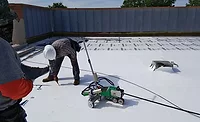Insurance Claim Recovery
Roofing contractors are confronting insurance issues on several levels in this day and age. In addition to liability insurance for the company and health insurance for employees, some contractors have also seen the need to help their clients with the complicated process of insurance claim recovery services pertaining to property damage. The goal is to help customers secure the necessary funds for a proper restoration project. The damage can be from normal weather issues of wind, rain and hail; or it can also be from human error like foot traffic, negligence, mold, asbestos or construction defect.
One nationwide company that specializes in insurance claim recovery is Paramount Disaster Recovery Inc., Palos Verdes, Calif. In business since 1953, Paramount represents the property owner’s interest in disaster situations. Success also requires working closely with local contractors, especially roofing contractors. The company’s reputation has drawn some of America’s finest roofing and waterproofing consultants, construction estimators, engineers, architects, mold hygienists, attorneys and even insurance professionals as the backbone of the firm.
More often than not, property owners do not understand the roofing or construction process, and thus cannot accurately portray their needs or substantiate their claims to the insurance company. On the other hand, Paramount understands insurance and can usually get a claim processed for maximum acceptance. Then Paramount works with quality contractors to ensure that the building owner receives high-quality repairs or replacement. It is a win-win process for all involved.
In a recent example, a large home owners association complex contracted with a termite extermination company. The company’s technician walked over the entire tile roof causing significant foot traffic damage to the roof tiles. Cal Shake, a discontinued roofing product, had been used on the roof thus making the damage sustained not repairable. When the insurance company completed its inspection, it notified the HOA of its decision not to pay for the roof because of the defective roofing material.
As Paramount worked on the case, a team of its experts was able to establish that the cause of the broken tile was not due to the defective material but rather the footfall of the exterminators. The term “footfall” was a covered loss in the insurance policy by the HOA’s insurance company. Coverage was established and the HOA was paid in full to have all of the roofs replaced.
Another example is a recent high-profile insurance claim case involving Ed McMahon, formerly of the Tonight Show. According to a recent article on ABCNews.com, McMahon claimed the insurance company botched a simple repair of a broken pipe resulting in a black toxic mold spreading through his 8,000-square-foot, six-bedroom Beverly Hills mansion.
Although not a roofing problem in this instance, the issue of mold infestation is a growing issue throughout all construction trades. In this case, the insurance company arranged to clean up the mess, but McMahon’s lawsuit says that the contractors that the insurance company recommended simply painted over the mold — known as stachybotrus chartarum — and didn’t give McMahon any reports about the infestation. Soon after the incident, McMahon says he and his wife became seriously ill, and their sheepdog, Muffin, developed respiratory problems and died. The McMahon family is suing their insurance company and the contractors who were involved for $20 million.
During the McMahon case, one of Paramount’s mold experts was interviewed. This person had completed a similar project for another homeowner close to the McMahons’ home. He was able to share the proper methods of mold abatement with the news crew. “If there is an area of water intrusion or roof leak there is a good chance that mold will result,” said Steve Slepcevic, president of Paramount Disaster Recovery Inc. “If not handled by a mold abatement professional and the mold is disturbed, it can become airborne and contaminate the adjoining areas of the property. We have trained crews to identify and document the problems.”
The McMahons have moved out under doctor’s orders after a high concentration of the mold was found in their master bedroom. Their home will need considerable work before it’s habitable again.
Another example of a roofing disaster recovery was during a recent El Nino storm when high winds caught the corner of a commercial building’s flat roof, blowing it off. The sub-surface insulation was exposed and soaked up a tremendous amount of rainwater.
“The property owner immediately notified and submitted a claim to his insurance company,” noted Slepcevic. “The insurance company sent out their adjuster and followed up with a denial letter stating that on the date the owner submitted as the date of loss, the winds were only 17 miles an hour and could not have caused the damage. Frustrated, the property owner felt it was an unfair approach to the claim and called us.”
By pulling wind data charts for that entire week, Paramount was able to resubmit the claim to reflect the correct date, one day later. The roof had received substantial damage. And yet upon review, the insurance adjuster agreed to pay only for a patch repair to the damaged portion. He stated that according to his experts, that is all the company owed; it would not pay to replace the entire wind- and water-damaged roof.
Paramount’s in-house roof consultants and insurance claims experts pointed out that the repair patch, which the insurance company was calling a permanent solution, would only be functional for approximately a year. This was due to the improper tie-in method into an older roof system, in addition to the fact that the wet insulation would not be able to properly dry out. The water damage and residue moisture would further cause serious problems because of the insurance company’s delay in properly addressing the damage. Mold growth had already formed on the interior of the building within just three days.
In addition to a local roofing contractor, the restoration of the property included utilizing a mold hygienist and specialized mold-abatement crews, securing a clean air certificate and complete restoration to the interior of the building. A new roof system was installed to code with all new warrantees. What started out, as a $1,500 roof patch to the insurance company became $380,000 in replacement services. The insurance company paid the replacement claim for the correct restoration of the property and the roofing contractor obtained an excellent job.
These examples show the benefit of involving insurance claims specialists for the benefit of both the owner and the contractor. Companies like Paramount participate throughout the entire claims process by providing emergency services, preparing a scope of repairs, and facilitating claim negotiation and complete restoration. This process creates fair pricing for the contractor to perform a thorough and complete job, while the building owner has only one out-of-pocket expense: the deductible.
In closing, keep in mind that insurance companies follow strict policy rules for submittal and areas of coverage. Often one word can be the cause for a claim rejection. It is in the roofing contractor’s best interest to enable the building owner to submit claims accurately so that all parties involved can receive fair compensation. An insurance company will only pay for what it owes. It is up to the building owner to justify and understand what they are entitled to.
Looking for a reprint of this article?
From high-res PDFs to custom plaques, order your copy today!







